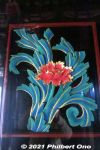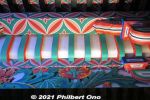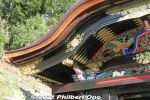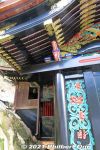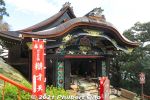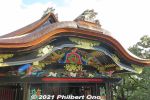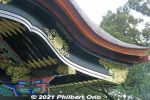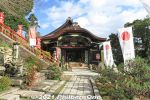 Image search results - "gate" Image search results - "gate" |

Shinmon Gate 神門
|
|

Nezu Shrine bridge (built in 2006 神橋) and gate, Important Cultural Property 楼門(国指定重文)
|
|

Sensoji temple's Kaminarimon Gate. There's a large road in front and also a large paved area where festivals are held. 雷門
|
|

Symbol of Tokyo: Kaminari-mon Gate with a giant red paper lantern. Pass through this gate to reach Asakusa Kannon Temple. 雷門
|
|

One of Tokyo's most photographed buildings: Kaminari-mon Gate with a giant red paper lantern.
|
|

Giant red paper lantern with the kanji characters "Kaminari Mon." The gate was reconstructed in 1960. The previous one was lost in a fire in 1865.
|
|

Under the lantern on the gold cap, there's "Matsushita Denki" (Matsushita Electric Industrial Co. or Panasonic). The current Kaminarimon Gate and giant lantern were rebuilt in 1960 as a donation by Konosuke Matsushita.
|
|

The lantern is covered with a protective net. The lantern can be collapsed like an accordion to allow tall objects (such as a mikoshi portable shrine during the Sanja Matsuri festival) to pass under the gate. It is also collapsed during typhoons.
|
|
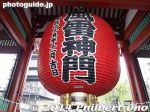
The famous Kaminarimon lantern was replaced with a new one in Nov. 2013. This is the back.
|
|
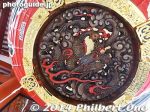
The bottom of the new Kaminarimon lantern has this nice artwork.
|
|

The temple is also called Kinryuzan, meaning Golden Dragon. 金龍山
|
|
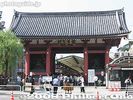
An unusual time when the giant lantern was removed for repairs. Asakusa looks very strange, almost naked, without the giant lantern.
|
|

Approaching another gate called Hozomon Gate. 宝蔵門
|
|

Hozomon Gate ahead. 宝蔵門
|
|
|

Hozomon Gate, means "Treasure Storage Gate." Indeed, the second floor houses important cultural properties. The gate was reconstructed in 1964, a ferroconcrete building.宝蔵門
|
|

Being the main gate, Hozomon Gate is much bigger than Kaminarimon Gate, and it also had a giant paper lantern.
|
|

Hozomon Gate
|
|

Hozomon Gate's giant paper lantern.
|
|
|

Behind Hozomon Gate is a pair of giant straw sandals hanging on the wall.
|
|

Giant straw sandal.
|
|

5-story pagoda reconstructed in 1973, made of ferroconcrete. Roof tiles made of aluminum alloy. 五重塔
|
|

Nitemon Gate in the east undergoing renovations. One of the few original buildings still intact. 二天門
|
|

Nitemon Gate after renovations. Fresh paint makes it bright red. 二天門
|
|
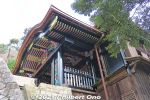
Karamon Gate (National Treasure)
|
|
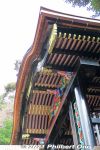
Karamon Gate roof eaves.
|
|
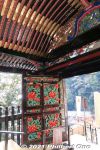
Karamon Gate door.
|
|
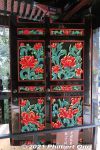
Karamon Gate door.
|
|
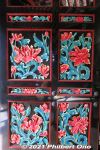
Karamon Gate door.
|
|
|
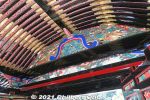
Behind the Karamon Gate.
|
|
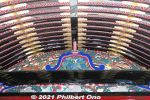
Behind the Karamon Gate.
|
|
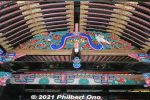
Front of Karamon Gate.
|
|
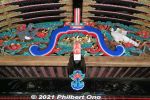
Nest of birds in this decorative, hump-shaped wood support called "kaeru-mata" (蟇股). Commonly found on entrances of important buildings. In Nikko, Toshogu Shrine's famous "Sleeping Cat" carving is also a kaeru-mata.
|
|
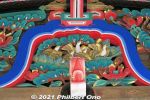
Closeup of the "kaeru-mata" showing a nest of birds. (蟇股).
|
|
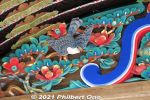
Left side of the kaeru-mata.
|
|
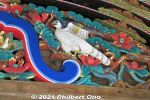
Right side of the kaeru-mata.
|
|
|
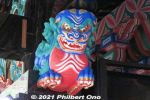
One of the lion dogs on Karamon Gate. Brought back to life from a drab-looking brown. It's part of a wooden protrusion called the "kibana" (木鼻).
|
|
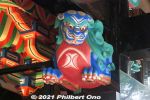
One of the lion dogs on Karamon Gate. It's part of a wooden protrusion called the "kibana" (木鼻).
|
|
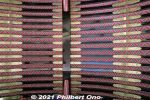
Ceiling inside Karamon Gate, looking directly upward.
|
|

Karamon Gate 唐門 (National Treasure) before it was restored in March 2020. See the next photo.
|
|
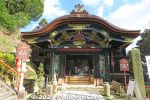
Karamon Gate 唐門 (National Treasure) beautifully restored to its original splendor. Entrance to the Kannondo Temple.This gate is said to have come from Toyotomi Hideyoshi's Gokuraku Bridge at Osaka Castle in the early 17th century (Momoyama Period). Chikubushima, Nagahama, Shiga.
|
|
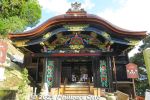
Karamon Gate looks new, but it's actually over 400 years old. "Karamon" (唐門) is a generic term for Chinese-style gates.There are other Karamon Gates in Japan, namely the more elaborate one at Nishi Hongwanji Temple in Kyoto. Karamon have colorful and intricate wood carvings and decorative features.
|
|
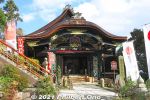
It looks new because it was magnificently restored (including the roof) after six years of meticulous work completed in March 2020. Finally came to see it. I was not disappointed. It's jaw-dropping beautiful.
|
|
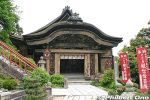
Karamon Gate before the restoration. Very drab-looking with most of the paint and lacquer weathered away by the elements after 67 years when it was last repainted.
|
|
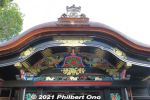
It's the entrance of the temple's Kannon-do Hall that worships Kannon. The gate features the karahafu roof gable shaped like a hump, commonly found on important traditional buildings such as temples and castles.
|
|
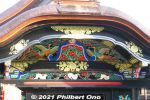
The roof was also entirely restored. The gate is a splendid example of the finest art from the Momoyama Period (late 16th century).
|
|

Before photo. Without the colors, it was so hard to see the wood carvings.
|
|
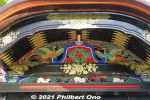
Some of the wood carvings had pieces that broke off or worn out. So they were reconstructed too. The metal fittings were also re-plated or remade.
|
|
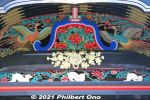
Never noticed those white rabbits before...
|
|
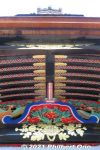
It's really pleasing to see this and other major National Treasures being restored during the past 10 years. There's also Nikko Toshogu Shrine in Tochigi and Menuma Shodenzan Temple in Saitama which have been refreshed with vibrant colors and laWith modern technologies, computers, laser measurements, and scientific techniques, restoration specialists can more accurately assess and reproduce the original colors and pigments. But much of the work is done by hand.
|
|
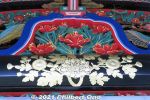
The only damper on this stupendous work is that, the contractor who did the job and the local government employee in charge of the project were found to have colluded to rig the bidding process. The project's budget was leaked to the contractor before the bidding started. Both parties were arrested a few months after the job was completed. At least the police waited until the job was done before arresting them.
|
|
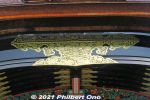
Center metal fitting on the Karamon.
|
|
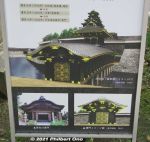
Karamon Gate was originally built in 1596 as the gate for a covered wooden bridge named Gokuraku-bashi (極楽橋) at Osaka Castle as depicted here.
|
|
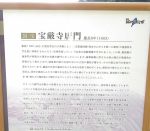
The gate and other castle structures were later moved to warlord Toyotomi Hideyoshi's mausoleum in Kyoto in 1600. In 1603, Hideyoshi's son ordered Karamon Gate to be moved to Chikubushima to help rebuild Hogonji Temple which was in disrepair at Chikubushima had close ties to Toyotomi Hideyoshi since he was once the lord of Nagahama Castle. Chikubushima was part of his domain.
|
|
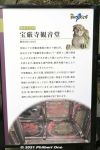
About the Kannon-do Hall.
|
|
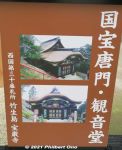
What the Karamon looks like with the doors closed.
|
|
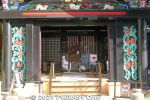
Karamon Gate entrance to Kannon-do Hall.
|
|
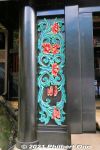
Left door of Karamon Gate.
|
|
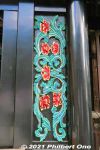
Right door of Karamon Gate.
|
|
|
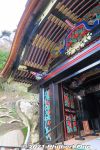
Left side of Karamon Gate. The gate doors are also adorned with peony flower carvings.
|
|
|
|
|
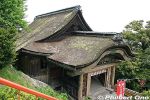
Before the renovation, Kannon-do and Karamon Gate had this old, moldy roof.
|
|
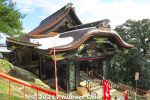
The roof was also rethatched with new cypress bark. The last time the building was reroofed was in 1972. (The white patch is snow.)
|
|
|
|
|
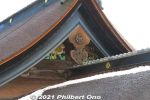
A pair of tigers on the main roof.
|
|
|
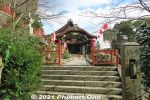
Path to Karamon Gate.
|
|
|

Higashimon East Gate (closed)
|
|

Kitahane-bashimon Gate. Right behind the castle tower foundation. 北桔橋門
|
|

Otemon Gate, Edo Castle's main gate. 大手門
|
|
|
|

Otemon Gate 大手門
|
|

Otemon Gate 大手門
|
|
|

Doshin Bansho Guardhouse where guards kept watch on the entourage of daimyos visiting the castle. 同心番所
|
|
|

Daibansho Guardhouse 大番所
|
|
|

View of Hakucho moat from Shiomizaka Slope 汐見坂 白鳥濠
|
|
|
|
|

Sakashita-mon Gate 坂下門
|
|

Sakashita-mon Gate, closest to the Imperial Household Agency and entrance to Inui-dori, a 600-meter path lined with cherry blossoms. 坂下門坂下門
|
|

Sakuradamon Gate 桜田門
|
|

Sakuradamon Gate, near here was where Lord Ii Naosuke from Hikone was assassinated. 桜田門
|
|

Sakuradamon Gate 桜田門
|
|

Sakuradamon Gate 桜田門
|
|

Sakuradamon Gate
|
|

Sakuradamon Gate
|
|

Sakuradamon Gate, rear view
|
|
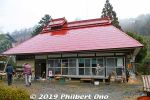
Former farmhouse converted into an artist's studio and gallery called "Arigatee" (pronounced "Ariga-tay" ありがてえ). It means "thankful" (arigatai) in the local dialect. It's also named after the former owner
|
|
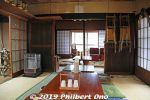
Arigatee is 150 years old built in the late Edo Period. This house will be accepting artist-in-residence as well.
|
|

Arigatee's current caretaker is Ishiwata Norio and his wife Chifumi (石渡のりお・ちふみ). They moved here from Tokyo. He uses it as a artist studio. That's his painting on the wall.Kita-Ibaraki is promoting itself as an art city, and Arigatee is part of the project. Ishiwata-san and his wife were very gracious and a real boon to the city's artist community.
|
|
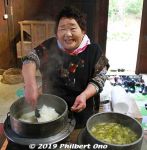
At Arigatee, we were charmed by the delightful Sumi-chan, a retired local farmer. She helped cook our lunch. Rice locally grown in Kita-Ibaraki. Thank you Sumi-chan for smiling!
|
|
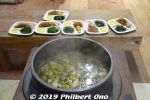
The miso soybean paste in the tonjiru pork miso soup was made by Sumi-chan, a "miso meijin" (味噌名人) or expert miso cook.
|
|

Ishiwata Chifumi and Sumi-chan.
|
|

Our table for lunch in the main room of Arigatee.
|
|
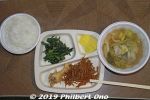
Our lunch at Arigatee. Chicken drumstick, vegetables, rice, and tonjiru (pork and vegetables) soup.
|
|
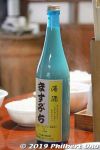
Local sake, a type called Doboroku (どぶろく) or nigori-zake (濁り酒). It's thick and cloudy-white. Sour taste. Made by a local brewer and restaurant named Masubuchi (増渕魚園).
|
|
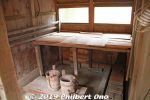
Former horse stable.
|
|
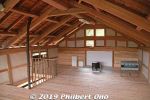
Former horse stable's attic will become a gallery space.
|
|
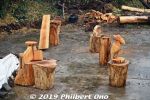
Chain saw sculptures.
|
|

Two-story Romon Gate, Important Cultural Property. 楼門
|
|

Figure in gate
|
|

Hikawa Shrine gate 楼門
|
|

Hikawa Shrine gate, Omiya, Saitama 楼門
|
|
|
|
|
|

Omotemon Gate, another Important Cultural Property
|
|

Omotemon Gate 表門
|
|

Omotemon Gate, one of two Edo-Era structures in Shibata Castle and an Important Cultural Property. 表門
|
|

Stone wall with perfectly-fitting stones. No gaps between the stones.
|
|

Higashi Gomon Gate and bridge
|
|
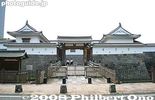
Sumpu Castle's Higashi Gomon Gate and bridge 東御門
|
|

Higashi Gomon Gate and bridge 東御門
|
|
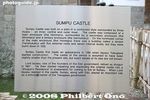
About Sumpu Castle
|
|

Higashi Gomon Gate Bridge
|
|

Higashi Gomon Gate 東御門
|
|

Gate door
|
|

Higashi Gomon Gate 東御門
|
|

Stone wall of Higashi Gomon Gate
|
|

Higashi Gomon Gate 東御門
|
|

Higashi Gomon Gate
|
|
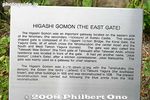
About Higashi Gomon Gate
|
|
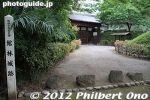
Tatebayashi was a castle town, but almost nothing remains of the castle. This Dobashi Gate was rebuilt in 1983.
|
|
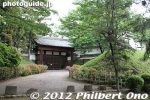
Tatebayashi Castle's Dobashi Gate is in the former Sannomaru keep of the castle. 土橋門
|
|
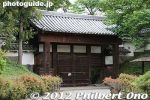
Tatebayashi Castle's Dobashi Gate. 土橋門
|
|

Tatebayashi Castle's Dobashi Gate was at the Sannomaru keep. 土橋門
|
|

On the west side is this Kurogane-mon Gate with steel doors. This is another way into the the main Honmaru grounds. During the Boshin War, the castle lord directed his troops from here. 鉄門
|
|

Club Alliance and gate to the US Navy Base.
|
|
|
|
|






























